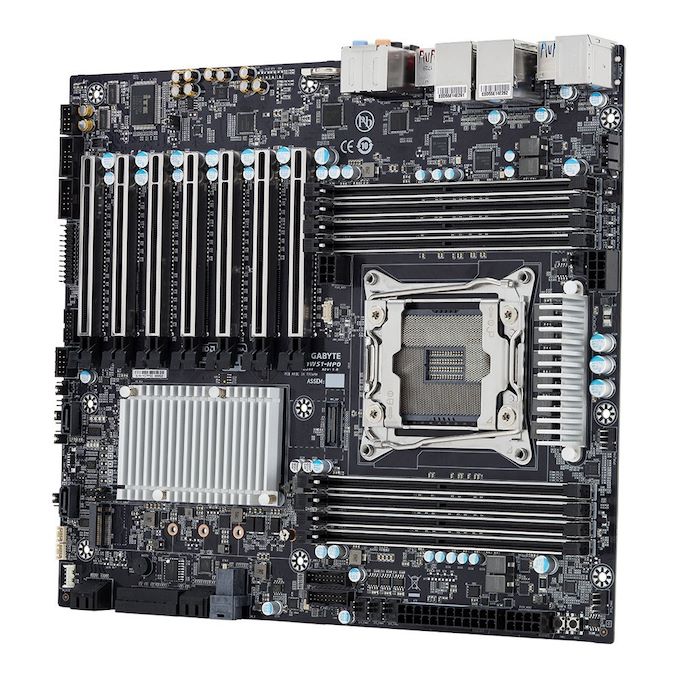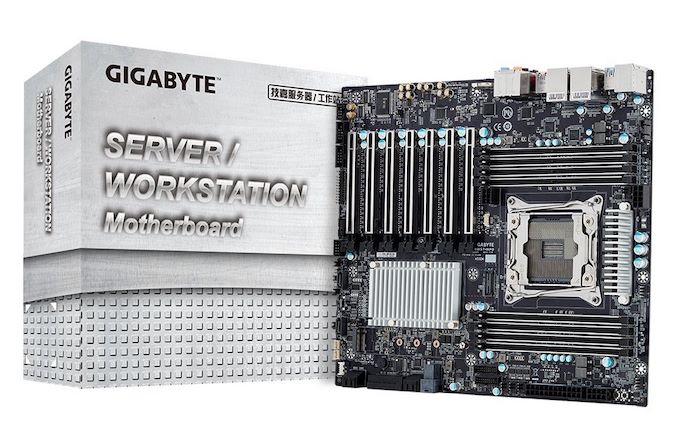The GIGABYTE MW51-HP0 Motherboard Review: Consumer Meets Workstation for Xeon W
by Gavin Bonshor on March 6, 2019 9:30 AM EST- Posted in
- Motherboards
- Intel
- Gigabyte
- Workstation
- server
- Xeon-W
- C422
- MW51-HP0
Closing Thoughts
As one of Gigabyte's four Xeon-W compatible motherboards, the MW51-HP0 represents the most consumer-like of the bunch. The other models include the MF51-ES2, the MF52-ES1 and the MF51-ES0, all of which feature a blue PCB with an inclusive Aspeed AST2500 remote management controller; something the MW51-HP0 doesn’t benefit from. Most of the GIGABYTE MW51-HP0's feature set is consistent with what you'd expect for a professional motherboard, and with seven full-length PCIe 3.0 slots assisted by a Broadcom PEX8747 PLX chip, the board proves a solid foundation for building a high-end workstation.
In terms of the design of the MW51-HP0, it takes elements found on other professional motherboards such as simple-looking silver aluminum heatsinks. The chipset heatsink is large and flat, with its job to cool both the C422 chipset and the Broadcom PEX8747 PLX chip. More consumer-specific features include metal slot reinforcement on all seven of the full-length PCIe 3.0 slots, as well as around the eight RAM slots. This not only adds function through physical protection, but it adds a more premium styling to the board's overall look. Overall the black PCB and contrasting silver parts make this an attractive-looking board with neutral tones.
The closest thing the board offers in terms of a marquee feature is its PCIe lane configuration, which is augmented by the PLX controller. As a result the top slot can always operate at full bandwidth (PCIe 3.0 x16), while the rest of the slots share bandwidth with the corresponding slot below, allowing for x16/0 or x8/x8 operation for each pair. The board can run four dual slot cards all at PCIe 3.0 x16, or seven single slot cards at PCIe 3.0 x8; while as previously mentioned, the top PCIe 3.0 slot always runs at x16.
Other notable points to touch on include the USB connectivity, with the MW51-HP0 supporting up to 16 ports. On the rear panel is a pair of USB 3.1 Gen2 ports including a Type-A and Type-C on the rear panel, as well as eight USB 3.1 Gen1 Type-A ports. Meanwhile four USB 3.1 Gen1 Type-A ports and two USB 2.0 ports are exposed through internal headers.
Storage is provided by ten SATA ports with two separated by a Marvel 88SE9172 SATA controller; this adds support for two SATA DOM drives, which shares bandwidth with the two straight-angled SATA ports along the bottom of the board. Also featured is an Intel VROC connector for users looking to run PCIe SSDs in RAID, and users looking to use a single M.2 drive can use a PCIe M.2 card up to 22110 in size. Meanwhile with dual Intel I210-AT GbE LAN ports and a Realtek ALC1150 HD audio codec, the MW51-HP0 can handle more than just workstation use, but the primary function and feature set is consistent with what’s expected from a consumer-based workstation system.
Looking at performance then, with support for up to 140 W TDP Intel Xeon W processors, GIGABYTE's board can be paired with a wide range of CPUs. In the case of our testing and our relatively high-end Xeon W-2155, the board's performance was very competitive. Even more exemplary was its quick UEFI POST times and low DPC latencies, despite us not making any out of the box optimizations.
The GIGABYTE MW51-HP0 has an eye-catching price tag of $567, which although not cheap is fair given the feature set and all of the onboard controllers. Users looking to use multi-RAID controllers with support for VROC, external PCIe sound cards for a dedicated DAW, or even networking adapters can really make use of the available PCIe slots. And with support for up to 512 GB of ECC DDR4 memory, builders shouldn't find themselves short on memory. Overall then, the MW51-HP0 is positioned to offer a solid foundation for a high-powered workstation, offering not only plenty of PCIe lane support, but an aesthetically pleasing look too. All of which stands out nicely compared to the likes of the other, more Enterprise IT-focused boards in GIGABYTEs CEB C422 lineup.













33 Comments
View All Comments
colonelclaw - Wednesday, March 6, 2019 - link
The lack of 10GB Ethernet mars what is otherwise an attractive bit of kit, both technically and aesthetically.imaheadcase - Wednesday, March 6, 2019 - link
Well since this board is not for %99 of readers on this site, its more than likely if you are spending that much for a board you going to get stand alone NIC for that. Anandtech likes to for some reason review stuff now that is business/IT/Phone related more than consumer stuff.Kevin G - Wednesday, March 6, 2019 - link
Big consumer stuff has, well slowed down. Sky Lake was released 3.5 years ago and since then Intel has boosted clocked, bumped up core counts and polished the chipset. AMD released Ryzen which got lots of coverage but the Zen+ refresh was mainly polishing off the first release. Zen 2 is still a little bit away so news will at least pick up on the consumer CPU side soon.The GPU side of things hasn't been that exciting as AMD and nVidia are seemingly content where they are in the market. The mining boom shifted prices upward which neither company is eager to reverse. The GTX 1660 Ti is actually a fairly big thing for consumers but that level of performance could be had years ago if you had the cash back then for a high end card. AMD's Navi will be another step forward for consumer but again will be over shadowed by the previous generation of highend hardware that carried higher prices.
I hope the next big thing is a wider product line up of gaming displays now that HDMI 2.1 has adopted variable refresh rate support, nVidia supports Freesync displays (soft of) and Intel will finally be adding Freesync support too. Things are lining up for this to go mainstream. Though much like CPU and GPU news, variable refresh rate support has been around for years on other hardware.
I see 2.5 and 5 Gbit hardware taking of on the consumer side along with 802.11ax (Wifi 6) enabled devices. Wireless is starting to move beyond a gigabit of bandwidth so the wired side of connectivity also has to evolve. Though it feels odd celebrating the release of 2.5 and 5 Gbit speeds when 10 Gbit has been around for years.
If you want a real wide guess of what the next big consumer thing will be that really hasn't spread in the high end yet would be network based audio transport. Stuff like PoE enabled network speakers that integrate with other smart home devices. Stuff like this exists on the professional side of things but even there you'd have to look for it.
gavbon - Friday, March 8, 2019 - link
Prosumer boards serve a purpose just as much as consumer desktop boards. I personally like focusing on consumer boards, but when I get asked to look at workstation boards, it makes a nice change!PeachNCream - Friday, March 8, 2019 - link
I would question the accuracy of the 99% statistic regarding readers. While I am myself a consumer as an individual, my profession is in enterprise computing and networking so products outside of the consumer space are of an interest to me as much as are consumer electronics. I think quite a few of us are in a similar state, working in information technology and reading to stay caught up on broader developments. Sure, individual workstation motherboards are a bit of an oddity as most workstations are major muscle movement purchases that are acquired from hardware company like HP or Dell, but they are still relevant so I'm happy to see them getting a little word count now and then.CheapSushi - Thursday, March 7, 2019 - link
Not even 10GB but 2.5G and 5G at least, especially now that controllers are more affordable. 2.5G should be basically standard now in 2019.Kevin G - Wednesday, March 6, 2019 - link
Typo on the first page:"A total of eight DDR4 channels are present and allow users to run memory in quad-channel memory mode"
I believe you mean eight DIMM slots in quad-channel memory mode.
Ryan Smith - Wednesday, March 6, 2019 - link
Thanks!Sivar - Wednesday, March 6, 2019 - link
You see, this is how to report a typo (or "thinko"). No sarcasm, attacks, or diatribe about how Anandtech must be a shill for the reviewed item's manufacturer.Just polite, factual, and tactful. Thank you!
kalm_traveler - Wednesday, March 6, 2019 - link
The Xeon W-3175x is not a 32 core chip; it is 'only' 28 core.